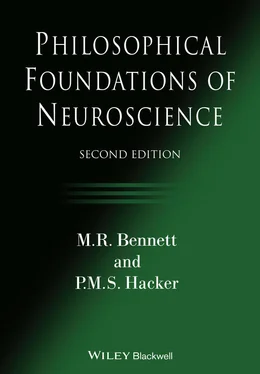Reply to Ullman: David Marr on ‘representations’
The accusation of committing the mereological fallacy cannot be that easily rebutted. But Simon Ullman may appear to be on stronger grounds when it comes to talk of internal representations and symbolic representations (as well as maps) in the brain . If ‘representation’ does not mean what it ordinarily does, if ‘symbolic’ has nothing to do with symbols, then it may indeed be innocuous to speak of there being internal, symbolic representations in the brain. (And if ‘maps’ have nothing to do with atlases, but only with mappings , then it may also be innocuous to speak of there being maps in the brain.) It is extraordinarily ill advised to multiply homonyms, but it need involve no conceptual incoherence, as long as the scientists who use these terms thus do not forget that the terms do not have their customary meaning . Unfortunately, they typically do forget this and proceed to cross the new use with the old , generating incoherence. Ullman, defending Marr, insists (perfectly correctly) that certain brain events can be viewed as representations* of depth or orientation or reflectance; 27that is, that one can correlate certain neural firings with features in the visual field (denominating the former ‘representations*’ of the latter). But it is evident that this is not all that Marr meant. He claimed that numeral systems (roman or arabic numerals, binary notation) are representations. However, such notations have nothing to do with causal correlations, but with representational conventions. He claimed that ‘a representation for shape would be a formal scheme for describing some aspects of shape, together with rules that specify how the scheme is applied to any particular shape’, 28that a formal scheme is ‘a set of symbols with rules for putting them together’, 29and that ‘a representation, therefore, is not a foreign idea at all – we all use representations all the time. However, the notion that one can capture some aspect of reality by making a description of it using a symbol and that to do so can be useful seems to me to be a powerful and fascinating idea.’ 30But the sense in which we ‘use representations all the time’, in which representations are rule-governed symbols, and in which they are used for describing things , is the semantic sense of ‘representation’ – not a new homonymical causal sense. Marr has fallen into a trap of his own making. 31He in effect conflates Ullman’s representations*, which are causal correlates, with linguistic representations, which are symbols or symbol systems with a syntax and meaning determined by conventions.
Reply to Ullman: Young on ‘maps’ and Frisby on ‘symbolic representations’
Similarly, it would be misleading, but otherwise innocuous, to speak of maps in the brain when what is meant is that certain features of the visual field can be mapped on to the firings of groups of cells in the ‘visual’ striate cortex. But then one cannot go on to say, as Young does, that the brain makes use of its maps in formulating its hypotheses about what is visible. So, too, it would be innocuous to speak of there being symbolic representations in the brain, as long as ‘symbolic’ has nothing to do with semantic meaning, but signifies only ‘natural meaning’ (as in ‘smoke means fire’). But then one cannot go on to say, as Frisby does, that ‘there must be a symbolic description in the brain of the outside world, a description cast in symbols which stand for the various aspects of the world of which sight makes us aware’. 32For this use of ‘symbol’ is evidently semantic. For while smoke means fire, inasmuch as it is a sign of fire (an inductively correlated indication), it is not a sign for fire. Smoke rising from a distant hillside is not a description of fire cast in symbols, and the firing of neurons in the ‘visual’ striate cortex is not a symbolic description of objects in the visual field, even though a neuroscientist may be able to infer facts about what is visible to an animal from his knowledge of what cells are firing in its ‘visual’ striate cortex. The firing of cells in V1 may be signs of a figure with certain line orientations in the animal’ s visual field, but they do not stand for anything, they are not symbols, and they do not describe anything.
Reply to the second objection (Gregory) that, in ascribing psychological attributes to the brain, neuroscientists are not committing the mereological fallacy, but merely extending the psychological vocabulary analogically
The thought that neuroscientific usage, far from being conceptually incoherent, is innovative, extending the psychological vocabulary in novel ways, might seem to offer another way of side-stepping the accusation that neuroscientists’ descriptions of their discoveries commonly transgress the bounds of sense. It is indeed true that analogies are a source of scientific insight. The hydrodynamical analogy proved fruitful in the development of the theory of electricity, even though electrical current does not flow in the same sense as water flows, and an electrical wire is not a kind of pipe. The moot question is whether the application of the psychological vocabulary to the brain is to be understood as analogical.
The prospects do not look good. The application of psychological expressions to the brain is not part of a complex theory replete with functional, mathematical relationships expressible by means of quantifiable laws as are to be found in the theory of electricity. Something much looser seems to be needed. So, it is true that psychologists, following Freud and others, have extended the concepts of belief, desire and motive in order to speak of unconscious beliefs, desires and motives. When these concepts undergo such analogical extension, something new stands in need of explanation. The newly extended expressions no longer admit of the same combinatorial possibilities as before. They have a different, importantly related meaning, and one which requires explanation. The relationship between a (conscious) belief and an unconscious belief, for example, is not akin to the relationship between a visible chair and an occluded chair – it is not ‘just like a conscious belief only unconscious’, but more like the relationship between √1 and √–1. But when neuroscientists such as Sperry and Gazzaniga speak of the left hemisphere making choices, of its generating interpretations, of its knowing, observing and explaining things – it is clear from the sequel that these psychological expressions have not been given a new meaning. Otherwise it would not be said that a hemisphere of the brain is ‘a conscious system in its own right, perceiving, thinking, remembering, reasoning, willing and emoting, all at a characteristically human level ’. 33
It is not semantic inertia that motivates our claim that neuroscientists are involved in various forms of conceptual incoherence. It is, rather, the acknowledgement of the requirements of the logic of psychological expressions. Psychological predicates are predicable only of an animal as a whole, not of its parts. No conventions have been laid down to determine what is to be meant by the ascription of such predicates to a part of an animal, in particular to its brain. So the application of such predicates to the brain or the hemispheres of the brain transgresses the bounds of sense. The resultant assertions are not false, for to say that something is false we must have some idea of what it would be for it to be true – in this case, we should have to know what it would be for the brain to think, reason, see and hear, etc., and to have found out that as a matter of fact the brain does not do so. But we have no such idea, and these assertions are not false. Rather, the sentences in question lack sense. This does not mean that they are silly or stupid. It means that no sense has been assigned to such forms of words, and that, accordingly, they say nothing at all, even though it looks as if they do.
Читать дальше












